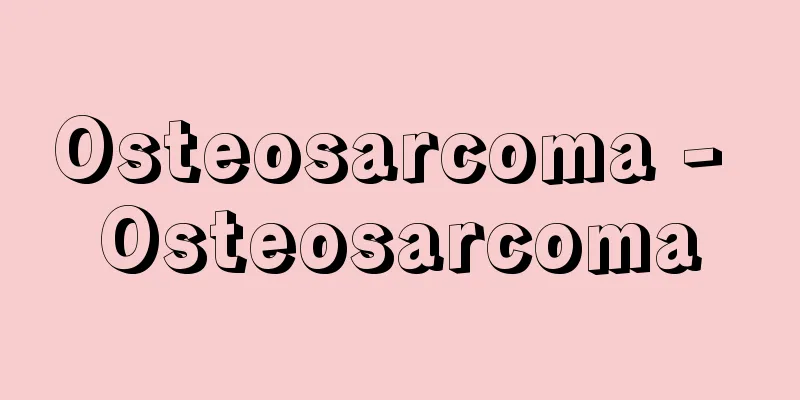Osteosarcoma - Osteosarcoma

|
[What kind of disease is it?] Osteosarcoma is the most common type of malignant bone tumor (bone cancer). To get a little more technical, the cells of this tumor have the ability to produce immature bone tissue. ●Frequency The Japanese Orthopaedic Association registers bone tumor patients from all over the country, and several hundred cases of osteosarcoma are registered every year. Although it is not clear what percentage this number represents of the total number of cancers, the incidence rate of all malignant bone tumors is said to be 0.8 per 100,000 people. Osteosarcoma accounts for approximately 40% of all malignant bone tumors. However, compared with stomach cancer and lung cancer, the incidence of osteosarcoma is extremely low. It is most commonly seen in young people, such as elementary school to university students, and the problem is that treatment outcomes are still not satisfactory. ● Age and gender The most susceptible age group is those in their teens, followed by those in their 20s and those under 10. The incidence decreases as people get older. The male to female ratio is 3:2, with men being slightly more affected. ●Locations where it is likely to occur Nearly half of these tumors occur at the lower end of the femur. The next most common area is the upper end of the tibia (the thicker bone below the knee). It can also occur at the upper end of the fibula (the thinnest bone below the knee), and 70 to 80% of cases occur around the knee. It is also relatively common in the upper end of the humerus (shoulder area). It can also occur in other bones, but the number of such cases is extremely small (see figure "Sites where osteosarcoma is likely to occur"). [Symptoms] At first, you may feel pain in your knee joints after running or jumping, or pain in your shoulder joints after throwing a ball. The pain subsides when you rest, so many people think it is sports pain. In fact, most pains are like that, but in the case of osteosarcoma, the pain gradually gets worse and becomes painful even when you are resting. At this stage, the affected area may become swollen, red, or hot to the touch. In addition, the joint may become less mobile (limited mobility) and the patient may start dragging their leg when walking (lameness). Most people visit a doctor at this time, two to three months after the pain first began. Therefore, in order to detect it early, if this pain continues for more than a month, you should visit an orthopedic surgeon to determine whether it is a bone tumor. [Testing and diagnosis] The simplest diagnostic method is an X-ray examination. Sometimes a diagnosis can be made based on X-ray images alone. However, if osteosarcoma is strongly suspected, other tests such as CT (computed tomography), MRI (magnetic resonance imaging), angiography (injecting a contrast agent into the blood vessels to take X-ray images), and bone scintigraphy (a test to find tumors by using images with isotopes) will be performed in addition to X-rays. We will also check the level of alkaline phosphatase in the blood (a substance that increases in the blood, especially in bone tumors), and perform lung X-rays and CT scans to check for metastasis to the lungs. The final diagnosis is made by performing a histopathological examination, in which a sample of tumor tissue is taken and examined under a microscope, and then combining the results of various tests. [Treatment] Treatment for osteosarcoma mainly involves surgery and chemotherapy, but sometimes radiation therapy is also used. If surgery is not possible, chemotherapy and radiation therapy are used. Surgical treatment: About 30 years ago, amputation surgery was performed to cut off the limb (arm or leg) where osteosarcoma developed, or disarticulation surgery was performed to separate the limb from the joint. However, with the development of chemotherapy, surgery that does not require amputation of the arm or leg has become widely used (limb-sparing surgery). During surgery, the tumor is removed, including the bone, and the removed bone is reconstructed using various materials, including artificial joints and artificial bone. This type of surgery is not possible for everyone. Limb-sparing surgery is a candidate for patients when the tumor is not too large, chemotherapy is effective, or major blood vessels and nerves can be avoided from being cut. ChemotherapyOsteosarcoma often spreads to the lungs when malignant cells become trapped in the bloodstream. Preventing this metastasis to the lungs is one of the important life-saving treatments. Therefore, once a diagnosis of osteosarcoma is confirmed, chemotherapy using anticancer drugs is performed. Chemotherapy has side effects such as nausea, vomiting, hair loss, and a decrease in white blood cells, but these will improve once the treatment is over. Chemotherapy will end about one year after starting treatment. Radiation Therapy: As a way to preserve an arm or a leg, some medical centers use surgery to separate the tumor from healthy tissue so that only the tumor is exposed to radiation (a method called intraoperative radiation therapy). If the tumor is in an area where surgery is not possible, radiation therapy may be used. Treatment results: For people who have not had metastasis to the lungs or other bones when treatment begins, the 5-year survival rate (survival rate after 5 years) is about 50%. For those who did not need to have their arms or legs amputated, the 5-year survival rate is over 70%. In other words, people who have not had to have their arms or legs amputated are in a better position. This also shows the importance of early detection and early treatment. People who have had an amputation or disarticulation will need prosthetic devices. Nowadays, excellent prosthetic limbs can be made, making it possible to walk without a cane. Regarding the cost of treatment, in the case of children, as this is classified as a "specific chronic childhood disease" as defined by the Ministry of Health, Labor and Welfare, if you go through the necessary procedures, you can receive medical expenses covered by public funds. If you are under 18 years old and develop this disease, you can receive medical expenses benefits until you are 20 years old. In addition, if the limb is amputated at the thigh, it is equivalent to a grade 3 disability on the physical disability certificate. If you submit a medical certificate (medical certificate for a person with a physical disability) from a doctor designated by the prefecture and complete the necessary procedures, you will be issued a disability certificate and will be able to receive various types of support. Source: Shogakukan Home Medical Library Information |
|
[どんな病気か] 骨肉腫は、悪性骨腫瘍(あくせいこつしゅよう)(骨のがん)のなかでは、もっとも発生数の多い腫瘍です。 少し専門的になりますが、この腫瘍の細胞は、幼弱な骨の組織をつくる能力をもっています。 ●頻度 日本整形外科学会では、全国の骨腫瘍の患者さんの登録を行なっていますが、毎年、百数十例の骨肉腫の患者さんが登録されています。 この数が、すべてのがん発生数の何%にあたるのか明らかではありませんが、全悪性骨腫瘍の発生率は、10万人に対して0.8人といわれています。また、骨肉腫は、悪性骨腫瘍全体の40%ちかくを占めています。 しかし、胃がんや肺がんに比べて、骨肉腫の発生数は、きわめて少ないといえます。 小学生から大学生といった若い年齢層に多くみられ、治療成績が、いまだに満足できるようなものではないことが問題点となっています。 ●年齢・性別 もっともかかりやすいのは10歳代、以下20歳代、10歳未満の順になっています。年齢が高くなるにつれて発生は少なくなります。 男女比は3対2で、男性にやや多く発生します。 ●発生しやすい部位 この腫瘍の半数ちかくは、大腿骨(だいたいこつ)の下端にできます。 つぎに多くみられる部位は脛骨(けいこつ)(膝(ひざ)から下の太いほうの骨)の上端です。 腓骨(ひこつ)(膝から下の細いほうの骨)の上端にも発生し、70~80%が、膝の周囲にできます。 上腕骨(じょうわんこつ)の上端(肩の部分)にも比較的多くみられます。 その他の骨にも発生しますが、その数はきわめて少数です(図「骨肉腫の発生しやすい部位」)。 [症状] はじめ、走ったり跳んだりした後に、膝の関節が痛んだり、ボールを投げたりした後に、肩の関節に痛みを感じたりします。 痛みは、安静にしていると軽くなるので、多くの人は、スポーツによる痛みと考えます。事実、大部分の痛みはそうなのですが、骨肉腫の場合は痛みがだんだん強くなり、安静時でも痛むようになります。 この時期になると、患部の腫(は)れ、発赤(ほっせき)(赤くなる)、熱感(さわると熱く感じる)、さらに関節の動きが悪くなり(可動性制限)、脚(あし)をひきずって歩いたりする(跛行(はこう))こともあります。 たいていの人が、この時期に医師を受診しますが、最初の痛みがおこってから2~3か月たっています。 したがって早期発見のためには、このような痛みが1か月以上も続く場合、整形外科を受診して、骨腫瘍であるかないかを確かめる必要があります。 [検査と診断] もっとも簡便な診断方法はX線検査です。X線像だけで診断ができることもあります。 しかし、骨肉腫の疑いが強い場合には、X線像のほかに、CT(コンピュータ断層撮影)、MRI(磁気共鳴画像装置)、血管造影(造影剤を血管に注入して血管のX線写真を撮るもの)、骨シンチグラフィー(アイソトープによる画像で腫瘍を見つける検査)などの検査を行ないます。 また、血液に含まれるアルカリホスファターゼ(とくに骨の腫瘍で血液中に増える物質)を検査したり、肺への転移を調べるために肺のX線検査やCT検査を行ないます。 最終的な診断は、腫瘍の組織の一部をとって顕微鏡で調べる病理組織学的検査を行ない、その結果と、いろいろな検査の結果を総合して決定します。 [治療] 骨肉腫の治療は、手術と抗がん剤などを使用する化学療法が中心ですが、ときに放射線療法が加わることもあります。 手術が不可能な場合には、化学療法、放射線療法が行なわれます。 手術療法 30年ぐらい前は、骨肉腫の発生した四肢(しし)(腕や脚(あし))を切断する切断術、関節から切り離す関節離断術が行なわれていました。しかし、化学療法の発達によって、腕や脚を切らないようにする手術が広く行なわれるようになりました(患肢温存手術(かんしおんぞんしゅじゅつ))。 手術では、腫瘍を、骨を含めて切除し、骨の切除された部分は、人工関節、人工骨など、いろいろな材料を用いて再建します。 こうした手術は、すべての人に行なうわけにはいきません。腫瘍がさほど大きくない、化学療法がよく効く、主要な血管や神経を切らずにすむ、といったときに、患肢温存手術の対象となります。 化学療法 骨肉腫は、血管に悪性の細胞が流れ込んで、しばしば肺に転移します。 この肺への転移を防ぐことが、生命を救うたいせつな治療の1つです。 そのため、骨肉腫の診断が確定すると、抗がん剤などを使った化学療法が行なわれます。 化学療法は吐(は)き気(け)、嘔吐(おうと)、脱毛(だつもう)、白血球減少(はっけっきゅうげんしょう)などの副作用をともないますが、治療が終われば回復するものです。化学療法は、治療を始めてから約1年で終了します。 放射線療法 腕や脚を温存する1つの方法として、手術で腫瘍の部分を健康な部分から分けて、腫瘍の部分にだけ放射線の照射を行なう方法(術中放射線療法)を行なっている医療施設もあります。 また、手術が不可能なところに腫瘍ができた場合は、放射線療法が行なわれます。 ●治療成績 治療を開始したときに肺や他の骨に転移していない人では、5年生存率(5年たった時点での生存率)は約50%となっています。このうち腕や脚を切らずにすんだ人では、5年生存率は約70%以上となっています。 つまり、腕や脚を切らずにすんだ人は、それだけ条件がよいといえます。 この点からも、早期発見・早期治療がたいせつであることがわかります。 切断や関節離断を行なった人には、義足(ぎそく)などが必要になります。 最近は、すぐれた義足をつくることができますので、歩行はつえなしで十分可能となります。 治療の費用については、子どもの場合、厚労省が定めた「小児慢性特定疾患」に含まれる病気なので、手続きをすれば、公費によって治療費の給付が受けられます。18歳未満でこの病気になった場合には、20歳まで延長して治療費の給付が受けられます。 また、大腿で切断された場合は、身体障害者手帳にある、3級の障害に相当します。 都道府県の指定医の診断書(身体障害者用診断書)を添えて、手続きをすれば、身体障害者手帳が交付され、いろいろなサポートが受けられます。 出典 小学館家庭医学館について 情報 |
>>: Osteomalacia - Osteomalacia
Recommend
High blood pressure
What kind of disease is it? ●Main symptoms and his...
Haba - Haba
〘Noun〙① In Joruri, this is the opening part of eac...
Ribes latifolium (English spelling) Ribes latifolium
… [Matsui Jin]. … *Some of the terminology that m...
Ashirabyoushi - Ashirabyoushi
... The music style of the flute can be considere...
Hichiso [town] - Hichiso
A town in Kamo District, central-southern Gifu Pre...
Chador
In Persian, it is a traditional black dress worn b...
Acoustotaxis - Acoustotaxis
…For example, moths and other insects fly toward ...
Bonhomme Noël
…Today, Santa Claus has been popularized as a kin...
Venezi
…the ancestors of the Western Slavs. In Latin, th...
The Compleat Angler
An essay by British essayist Izaak Walton. First ...
Ectoderm - Ectoderm
In animal embryos, this refers to a layered group...
Acrosome - Acrosome
…the head and tail are connected by a short neck....
Yabase Oil Field - Yabase Yuden
This oil field is located in the western part of ...
Amazonas Theater - Amazonas Theater
Teatro Amazonas is a theater located in the old to...
Bay rum tree (English spelling) bayrumtree
...The ripe red fruits are sometimes sold commerc...









